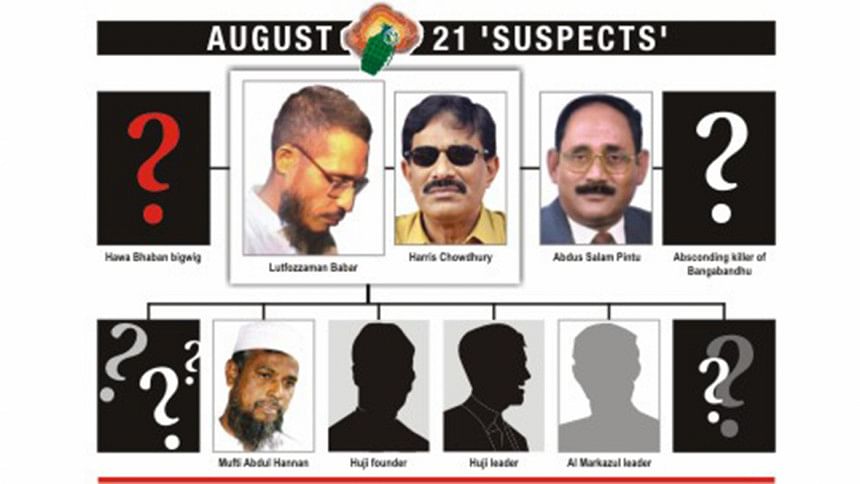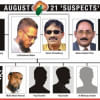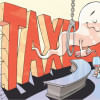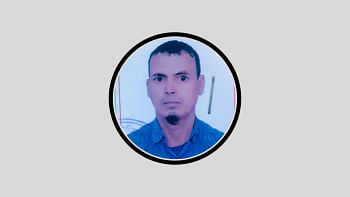It was Hawa Bhaban plot

It was a long, dark plot. A chilling conspiracy was getting final touches in an eerie August of 2004, a month that brings to mind the memories of a past bloodbath. The plot for a high-profile assassination was awaiting approval, again.
On August 14: At Hawa Bhaban -- the alternative powerhouse of the BNP-led coalition government. At least nine people sat to discuss a recommendation coming from a series of meetings in the past.
The Awami League was branded as the archenemy for the country and Islam, and it was recommended that its president Sheikh Hasina must die.
State minister for home Lutfozzaman Babar, deputy minister Abdus Salam Pintu, prime minister's political secretary Harris Chowdhury, a fugitive killer of Bangabandhu Sheikh Mujibur Rahman, a top Jamaat leader, two Huji founders and one leader of Al Markajul Islami found no reason to disagree.
In the presence of a top Hawa Bhaban bigwig, they chose to kill.
On August 15: At the same office, the same group sat again. This time they discussed how to accomplish the mission.
The fugitive killer suggested Hasina be attacked at her home, on road or at a rally. They settled for a rally, just six days away. Now it was time they chose weapons.
"Grenades are no problem," said Babar. Earlier on April 2, 10 truckloads of smuggled arms and ammunition were seized in Chittagong and two more trucks reportedly went missing. They decided to use grenades and rifles in the operation that was to be carried out either at Muktangon or in front of AL's central office on Bangabandhu Avenue. The government was dithering over the permission for the rally.
The Daily Star obtained a highly privileged document in which a top accused of the grenade carnage gave some descriptions about how the killing mission had been organised. Most of the people whose names surfaced in the narration are either in jail or on the run and could not be contacted for comment.
Apart from Huji leaders, this correspondent talked with investigators and intelligence officials involved with the probe over the last five years, who privately disclosed that Huji men had been used like mercenaries.
Huji made the first abortive attempt in Kotalipara way back in 2000, led by its leader Mufti Abdul Hannan.
Several groups had since pressed ahead with plots to assassinate Hasina, and the August 21, 2004 attempt was apparently under the patronage of some BNP-Jamaat leaders, said several intelligence and Huji sources.
Detained Salam Pintu is also maintaining the story he told interrogators upon his arrest in 2008 that the administration and Hawa Bhaban were behind the bloodletting.
"Go and interrogate Babar and beyond. You will find the truth," he was quoted as saying by different sources.
Jailed already for 17 years in an arms case, Babar was finally shown arrested in the case yesterday.
The Criminal Investigation Department will now quiz Babar to dig more into his alleged role and identify people beyond him in manipulating the administration to orchestrate the horrendous attack on Bangabandhu Avenue that missed its prime target Hasina but left 23 dead and over 300 injured for life.
However, investigators are not sure as yet if the hair-raising conspiracy was designed with or without the knowledge of the then prime minister Khaleda Zia. The alleged conspirators next gathered at Babar's official residence on Bailey Road without the Hawa Bhaban bigwig.
A friend of Babar, who was a transport businessman, was present for the first time at the meeting. He handed over Tk 50,000 to Huji leaders for petty expenses upon a review of nitty-gritty in the mission.
On August 18: Babar arrived at Abdus Salam Pintu's residence along with two black jeeps. At his instruction, BNP man Arifur Rahman Arif handed over a dozen of grenades to Huji leaders. Arif, also a Dhaka City Corporation commissioner from ward 53, is now in jail for links to two blast incidents at a CPB rally in Paltan and Narayanganj.
Sources said he had been also interrogated over his involvement in the August 21 incidents while on remand. At the time, Mufti Hannan was present along with Moulana Tajuddin, the younger brother of Salam Pintu who has strong connections with Pakistan-based extremist group Lashkar-e-Taiba.
Two boxes contained five grenades each and two more were partially wrapped. The grenades were marked with 'POF' (Pakistan Ordnance Factories), Huji sources told The Daily Star.
Though the exact number of attackers could not be confirmed, the document unearthed the presence of several groups apart from the Huji to carry out operations on the day. It also claimed that 15 people from Jamaat took part in the attack. The assailants struck at 5:22 in the afternoon.
An influential Huji leader blamed the failure on a lack of coordination among the groups even though they were reportedly assisted by a section of policemen and intelligence officials on the spot. None of the available documents -- the charge sheet of Fazlul Kabir, the third investigation officer in the case, and the confessional statement of Mufti Hannan -- could reveal all the details of the conspiracy before.
Preferring not to be named, a number of officials involved with the investigations told The Daily Star that the truth was buried deep under a heap of lies as Babar led the cover-up mission as soon as the operation fell through.
With the nation reeling from shocks, a few groups of intelligence and police officials were busy then destroying, not collecting, evidence systematically from the crime scene.
The evidence that could have been invaluable in the probes was swept under the rug, with unexploded grenades being detonated within nine hours after the attack.
Two bodies were reported unclaimed and buried in Azimpur graveyard, without any post-mortem. Steps had been taken to initiate stage-managed probes and fictitious characters were produced out of the blue to scuttle investigations throughout the tenure of coalition government.
Even a judicial investigation came into play a day after the attack. The one-man inquiry commission of Justice Joynul Abedin found out the hand of 'a foreign enemy country' in the incident in a quick probe that took only 40 days.
Under the direct supervision of Babar, a criminal investigation led to the arrest of 20 people, including a student, Shaibal Saha Partha, and AL leader and ward commissioner Mokhlesur Rahman. The arrestees had experienced a lot of harassment and torture but were not found guilty in the charge sheet.
A strange twist appeared in the mockery of probes as the government disclosed that a mere criminal gang had carried out the attacks and flashed the 'confession' of one Joj Miah as proof.
Finally, the caretaker administration found that those confessional statements had been obtained by force at the diktat of the BNP-led government.
CID investigators and supervising officer Ruhul Amin involved with the probe were found to have paid Joj Miah's family Tk 2,000 a month during his detention.
Joj Miah walked out of jail recently but three CID officials were 'assigned' to mislead the investigation by their own department.
Upon arrest on October 1, 2005, Mufti Hannan blurted out the involvement of his outfit in all terror attacks including the one of August 21. He was shown arrested in all but the August 21 case during the rule of BNP-Jamaat government. His confession was made officially public in 2007 during Fakhruddin Ahmed's caretaker rule.
Former CID inspector Munshi Atiqur Rahman said he tried for long to arrest Hannan following several bomb and grenade attacks but was not successful as the BNP-Jamaat government was 'reluctant'.
"They were soft on Mufti," said Atiq, adding that even a number of former ministers and lawmakers recommended relieving Hannan of different cases.
The blatant manipulation of the administration by the BNP government was nothing new, as its front-ranking leaders led by Tarique Rahman, Babar, and Aminul Haque made headlines by patronising Jama'atul Mujahideen Bangladesh from 2004.
Bangla Bhai, hanged by the caretaker government in 2007, boasted his relationship with Tarique and visits to Hawa Bhaban. However, amid AL insistence on international probes, the government had eventually let the FBI, Interpol and Scotland Yards fly in. But none of their observations or findings was made public.
On the other hand, Tarique's trip to the US in May 2005 following FBI's several visits to Bangladesh raised a lot of questions, speculation and curiosity both at home and abroad.
Strangely, Tarique visited both Pentagon and FBI along with former National Security Intelligence boss Major General (retd) Rezakul Haider Chowdhury. The outcome of the meetings is still under wraps.
Rezakul Haider is now detained and shown arrested in the 10-truck ammo haul case. Also, Tarique reportedly went to Dubai along with Rezakul for a meeting with mafia don Daud Ibrahim months before the lethal consignment smuggled into Chittagong.
Meanwhile, officials involved with the investigation appeared hopeful that more of the truth behind the attack is bound to come out in the further investigation by CID.
"Point of a compass can be taken from north to south by force, but, when freed, it comes back to its right place. In a free investigation, the truth will come out like that," an investigator told The Daily Star. But Salam Pintu differed in May while being quizzed again during the further investigation. "What is the point in having a further probe as the charge sheet as it is doesn't represent a complete investigation? A fresh investigation will only expose the links of all influential people behind the attacks."

 For all latest news, follow The Daily Star's Google News channel.
For all latest news, follow The Daily Star's Google News channel. 








Comments